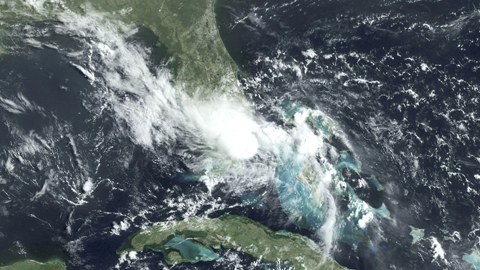A storm system moved toward the Gulf of Mexico oil spill area yesterday, forcing response crews to head inland for safety and halting work to plug the ruptured BP well.
Tropical depression Bonnie sent crews packing aboard 11 offshore platforms, a container ship and two rigs, as the evacuation also suspended at least 28 percent of Gulf oil production.
Officials said a cap that has kept oil from escaping the blown out BP well since last Thursday would stay in place, after a week of tests suggested pressure would not force oil out through new leaks.

PHOTO: REUTERS
Thad Allen, the US official overseeing the spill response, said the evacuation would set back efforts to finally “kill” the leaking well by several days, and could leave the cap unmonitored until the storm passes.
With the safety of workers at the well site a top concern, Allen said the rough weather had forced crews to collect boom and return ships to shore and some of the 2,000-strong crew responding to the spill headed back to land.
“The intention right now is to put the vessels in a safe place so they can return as quickly as possible to resume their operations,” he told reporters.
He said officials estimated that “if we abandon the scene, it would be 48 hours before we would be back on.”
The oncoming storm has forced a halt to the process of concreting the casing on the first of two relief wells.
Once concrete can be set, a process expected to take two days, officials hope to perform a “static kill” to plug the well by injecting heavy drilling mud and cement through the cap at the top.
The final operation to cement the reservoir through a relief well will take another week, Allen said.
Crews began preparing for the storm on Thursday, after forecasters said Bonnie could affect the entire northern Gulf Coast.
Bonnie struck south Florida as a tropical storm early on Friday, weakening into a tropical depression before it headed out over the Gulf, where the US National Hurricane Center (NHC) forecast it would strengthen again.
The center of the depression was about 135km southwest of Sarasota, Florida, early yesterday, the center said. While not expected to grow into a hurricane, Bonnie has renewed concern about severe storms hampering oil clean-up operations and worsening conditions along the coast, where 1,012km of shoreline have been oiled across all five US states on Gulf Coast.
The NHC predicted Bonnie would hit the northern Gulf Coast late yesterday, raising water levels by up to 1.5m above ground level.
Allen said the storm might be mild enough to allow some vessels to remain at the well site.
“The seismic survey vessels, the acoustic vessels and the vessels operating the ROVs [underwater robots] will stay as long as possible, and if conditions allow it they will remain through the passage of the storm,” he said.
But if the ships are forced to depart, engineers will have no real-time information about the state of the wellbore below the sealing cap.
Hydrophones will take recordings, but Allen said the information could only be analyzed after the fact.
Separately, a former rig worker told federal investigators that an alarm that should have alerted Deepwater Horizon workers to a deadly build-up of gas had been muted months before the April 20 explosion that sank the rig.
The system, which uses lights and alarms to warn of fire or high levels of toxic or explosive gases, had been “inhibited,” Mike Williams, the chief electronics technician on the rig, told a hearing looking into the disaster.
Rig owner Transocean sought to rebut Williams’s testimony, insisting the configuration was “intentional” and conformed to maritime practice.

Kehinde Sanni spends his days smoothing out dents and repainting scratched bumpers in a modest autobody shop in Lagos. He has never left Nigeria, yet he speaks glowingly of Burkina Faso military leader Ibrahim Traore. “Nigeria needs someone like Ibrahim Traore of Burkina Faso. He is doing well for his country,” Sanni said. His admiration is shaped by a steady stream of viral videos, memes and social media posts — many misleading or outright false — portraying Traore as a fearless reformer who defied Western powers and reclaimed his country’s dignity. The Burkinabe strongman swept into power following a coup in September 2022

‘FRAGMENTING’: British politics have for a long time been dominated by the Labor Party and the Tories, but polls suggest that Reform now poses a significant challenge Hard-right upstarts Reform UK snatched a parliamentary seat from British Prime Minister Keir Starmer’s Labor Party yesterday in local elections that dealt a blow to the UK’s two establishment parties. Reform, led by anti-immigrant firebrand Nigel Farage, won the by-election in Runcorn and Helsby in northwest England by just six votes, as it picked up gains in other localities, including one mayoralty. The group’s strong showing continues momentum it built up at last year’s general election and appears to confirm a trend that the UK is entering an era of multi-party politics. “For the movement, for the party it’s a very, very big

ENTERTAINMENT: Rio officials have a history of organizing massive concerts on Copacabana Beach, with Madonna’s show drawing about 1.6 million fans last year Lady Gaga on Saturday night gave a free concert in front of 2 million fans who poured onto Copacabana Beach in Rio de Janeiro for the biggest show of her career. “Tonight, we’re making history... Thank you for making history with me,” Lady Gaga told a screaming crowd. The Mother Monster, as she is known, started the show at about 10:10pm local time with her 2011 song Bloody Mary. Cries of joy rose from the tightly packed fans who sang and danced shoulder-to-shoulder on the vast stretch of sand. Concert organizers said 2.1 million people attended the show. Lady Gaga

SUPPORT: The Australian prime minister promised to back Kyiv against Russia’s invasion, saying: ‘That’s my government’s position. It was yesterday. It still is’ Left-leaning Australian Prime Minister Anthony Albanese yesterday basked in his landslide election win, promising a “disciplined, orderly” government to confront cost-of-living pain and tariff turmoil. People clapped as the 62-year-old and his fiancee, Jodie Haydon, who visited his old inner Sydney haunt, Cafe Italia, surrounded by a crowd of jostling photographers and journalists. Albanese’s Labor Party is on course to win at least 83 seats in the 150-member parliament, partial results showed. Opposition leader Peter Dutton’s conservative Liberal-National coalition had just 38 seats, and other parties 12. Another 17 seats were still in doubt. “We will be a disciplined, orderly